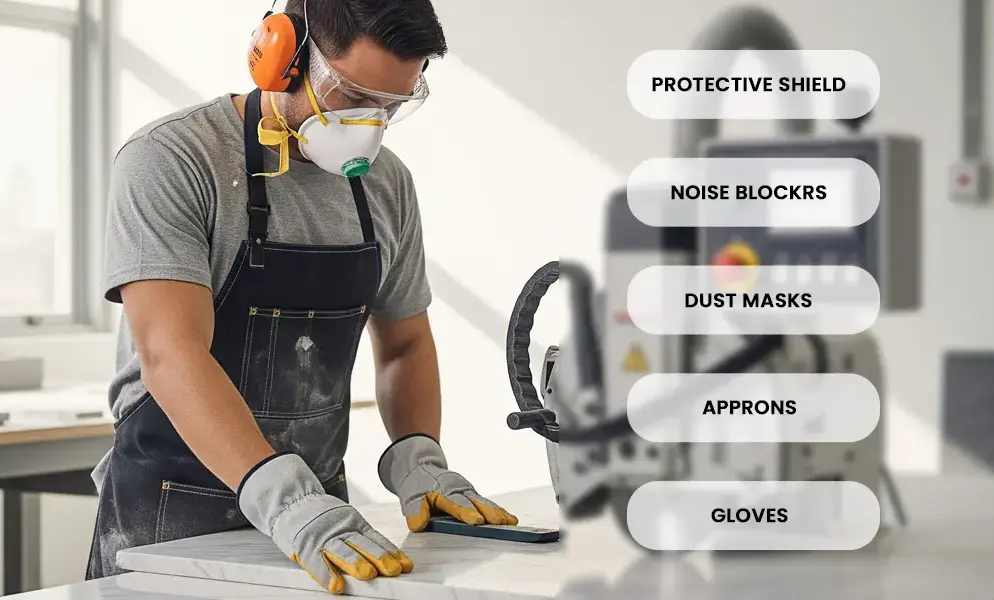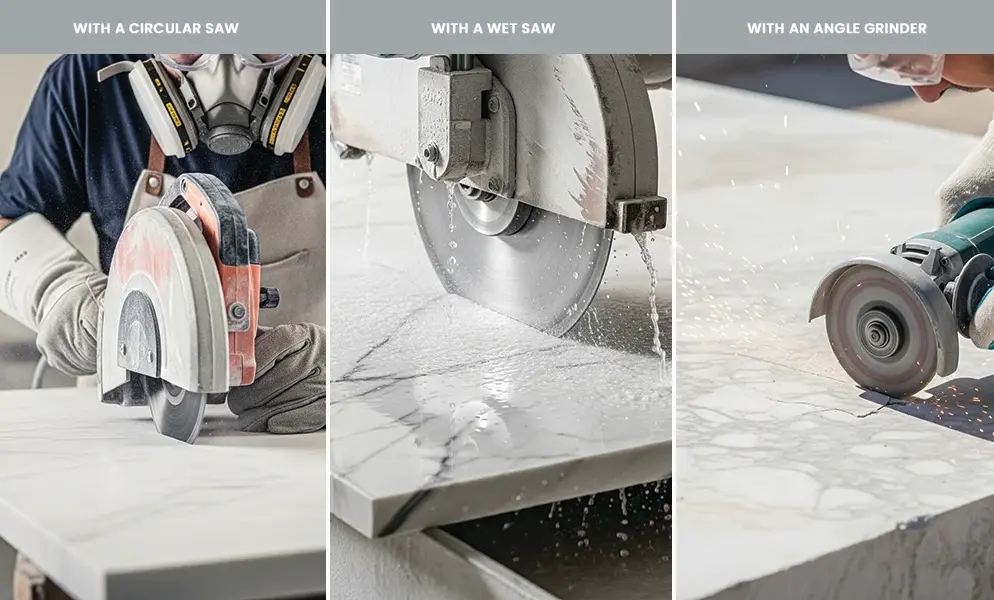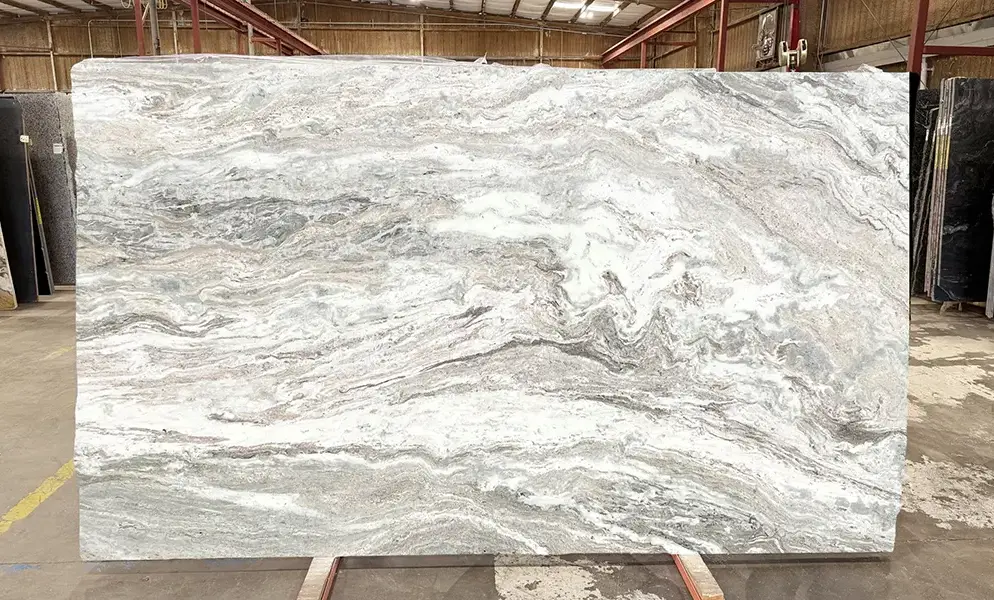How to cut marble: Step-by-step guide
Posted on 29 July 2025 | Author: Jaya Tripathi

Marble is known for its elegance and class. You can get marble slabs for your patio, tumbled marble for your bathroom floor, or one for your kitchen countertops. Regardless, at some point, you will have to cut the material.
Many homeowners are curious about the procedure and the safety tools to be used when installing the marble into the space.
This guide will take you through the whole process. It covers everything from the tools you need to make a safe, clean cut. This blog contains everything and more that you need to know about how to cut marble with ease.
Protect Yourself: Safety Guidelines for Cutting Marble

Being safe is as important as learning a new skill. In the journey of learning the art of cutting marble, keep the must-haves in mind.
a. Protective Eyewear: Protect your eyes from sharp, fraying marble, small dust particles, and unexpected sparks. You must wear safety goggles whether you are cutting marble tiles or grinding curved edges.
b. Dust Mask or Respirator: Marble dust can be harmful if inhaled. High-quality dust masks or respirators will help filter the fine particles out of the air that you might unintentionally breathe when making dry cuts. This is one of the crucial things to know when you are beginning to learn how to cut marble.
c. Wear Your Work Gloves: Sharp edges of marble and spinning blades can pose major risks to your hands. Wear quality gloves with a good grip, and the risk of cuts will be greatly reduced, with better control of your tools.
d. Ear Protection: Angle grinders and wet saws can be a little loud; make sure to protect yourself from noise. Exposure to loud noises can cause hearing problems. Earplugs, or over-ear protection, will make the work sound better and safer for your ears.
e. Protective Clothing or Apron: Use a heavy apron or wear old clothes to shield yourself from dust. This should be kept in mind, especially during dry cuts or when working with dense surfaces like a porcelain slab. This will protect you from dull and sharp items. It also reduces the clean-up work when you've done it.
f. Ensure Ventilation: Always cut the marble outdoors or in a workspace with proper ventilation. It will minimise the risks to your health when working over long periods.
Some Important Requirements for Cutting Marble
1. Cutting tools
a. Angle Grinder with Diamond Blade: The angle grinder tool is used for smaller or curved cuts for marble. It is utilised on decorative marble pieces such as rainforest brown marble. The diamond blade allows a nice clean shape, and since it is handheld, you can take it on-site to do any cuts you may need to do. An angle grinder is an important tool when it comes to learning how to cut marble or any natural stone.
b. Wet Saw: This is the most basic tool for cutting marble slabs, marble tiles, and marble countertops. Water flows in a steady stream to reduce dust, cool the blade, and prevent stone chipping. To cut polished high-end materials, you need a wet saw that operates without causing chipping.
c. Circular saw with diamond blade: You can consider a circular saw to cut stones like calacatta marble if you don't have a wet saw. It’s great for making long cuts on large marble countertops or porcelain slabs. Take your time with each cut. This will help reduce the risk of chipping or damaging the edges.
If you're starting to learn how to cut marble tile, it's essential to know the requirements of the cutting procedure in place to avoid injuries and long-term health issues.
2. Measuring and Marking Tools
a. Measuring Tape: Accuracy is key when learning to cut marble. A measuring tape will give exact measurements. It allows tiles or slabs to fit into walls, floors, or countertop areas perfectly.
b. Straight Edge: A straight edge will ensure you are making perfectly straight lines before cutting. It’s mostly used for cutting symmetrical marble tiles. It’s also great for trimming granite countertops, ensuring clean and aligned installations.
c. Pencil or Marker: Mark your cutting line with precision on the marble surface before you start cutting the marble. Use a pencil or a washable marker. This will help you see better and cut more accurately, especially with white swirls or light-coloured marble.
3. Support and Handling Tools
a. Clamps/Supports: While cutting a marble slab or tile, you should always clamp your marble slab or tile in place. You do not want it to move on you while you learn how to cut a marble tile, or when slicing a heavy marble slab; we want clamps to provide much-needed stability. Marble slabs are not easy to move, and they might not be flat.
b. Frame or Slab Support: When handling issues or projects with marble countertops and heavy slabs, a heavy slab A-frame is key. It helps transport the slab safely and keeps the marble flat while cutting.
4. Other Important Items:
a. Water source (Hose or Spray Bottle): Water is used to keep the blade cool, as well as to reduce dust and provide a smoother cut. This is important when using a wet saw or an angle grinder on softer stones.
b. Plastic sheeting: Drop cloths protect your floors and workspace from slurry, dust, and debris made during cutting.
c. Vacuum Cleaner with HEPA Filter: Marble dust settles quickly and can be inhaled, which may be harmful to your lungs. The idea here is to keep the area clean and not breathe in any harmful materials. With an understanding of how to cut a marble tile and learning about the right tools, this is the basic step to ace the decor of the space.
The Cutting Process of Marble: Step by Step

A. Cutting Marble with an Angle Grinder
An angle grinder is a versatile, handheld tool that's great for detail work, irregular cuts, or smaller marble pieces. Learn how to cut marble tile with the below are steps below:
a. Attach the blade: Disconnect the power and affix the diamond blade for marble cutting.
b. Mark the line: Mark the cutting line with a pencil and a ruler.
c. Take a grip on the marble: Secure it and slightly elevate it so that the workbench is safe.
d. Put on your safety equipment: Eyewear, gloves, dust mask, earplugs, etc.
e. Cut the Marble: Start with a light cut and make multiple shallow passes. Do not hurry, and let the blade do the cutting. Keep the blade cool by spraying water, or have another spray while cutting to minimise dust and maintain the blade's temperature.
These steps can make you a professional during the process of learning how to cut marble countertop, when done right!
B. Cutting with a Wet Saw
The wet saw is the best tool to make long, straight, and clean cuts on marble slabs or tiles with the least amount of dust. To cut the marble with a wet saw, below are the steps:
a. Check the equipment: Always ensure that the wet saw is on a sturdy, flat surface and that the reservoir is full of water flowing through the saw.
b. Place the slab: Hold the marble against the guide, and it should be flat on the tray.
c. Wear safety equipment: You should always be wearing safety goggles, gloves, and hearing protection.
Start the saw, and cut the marble with a gentle and consistent motion while applying minimal pressure.
Whether you are using a wet saw or an angle grinder, understanding how to cut a marble safely ensures not only a clean finish but also a smooth, injury-free experience.
C. Cutting with a Circular Saw
Diamond-blade circular saws are great for cutting large slabs and countertops, especially when you don’t have a wet saw. To cut the marble with an angled circular saw, below are the steps:
a. Create a guide: Use clamps to secure a straight edge that the saw will follow along the marble to cut a straight line.
b. Secure the Slab: Confirm that the slab is secure and prepare it before cutting. Make certain that the slab is held firmly in place. Also, check that you’re wearing all your protective gear.
c. Start Cutting: Start the saw and slowly pass the saw along the line you have drawn to cut the marble.
d. Make a double cut if necessary: If the slab is too thick, it might require a double cut, make it shallow, and finally give a finishing cut.
e. Control dust with a wet method: If you have a helper, ask them to mist the blade with water while you cut. This will help manage dust and keep the blade cool.
With all the above steps, you can easily learn how to cut marble countertop and design it as per your choice, without wasting a single inch.
Conclusion

Cutting natural stones like marble is easily possible with the right tools and techniques. Anything can work for you if you are patient and understand how the tools work. You can learn to cut marble safely and accurately, whether you're working with tiles, trimming a slab, or customising a countertop. Just follow the steps above.
Take your time, prioritise safety, and choose the method that suits your project. With practice, you'll learn how to cut a marble and achieve clean, professional-looking, remarkable results every time.
Ready to begin your marble project? Explore our collection of Calacatta marble, river blue marble, and more to get started.
About The Author
Jaya Tripathi is a seasoned content writer and editor with over a decade of experience in the stone and real estate industries. As a leading voice at MPG Stone, she shares insights on installment processes, project insights, design guides, and much more






Comments
No comments yet.
Leave a Comment